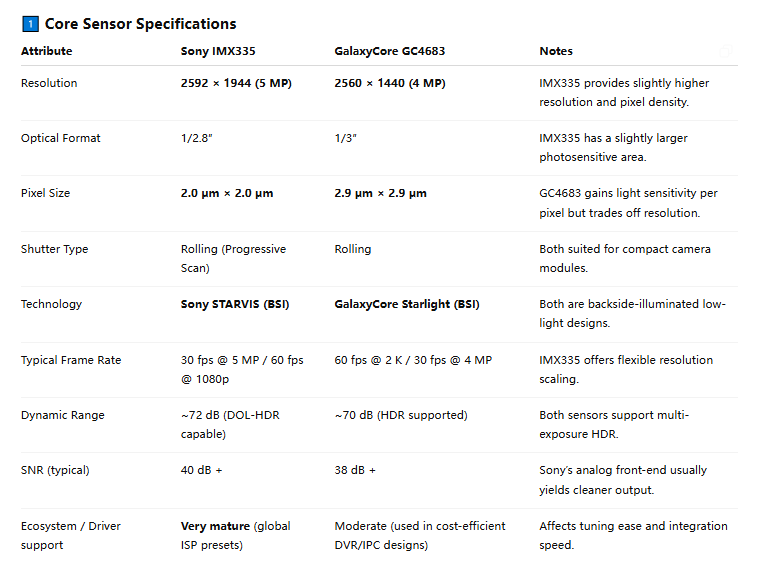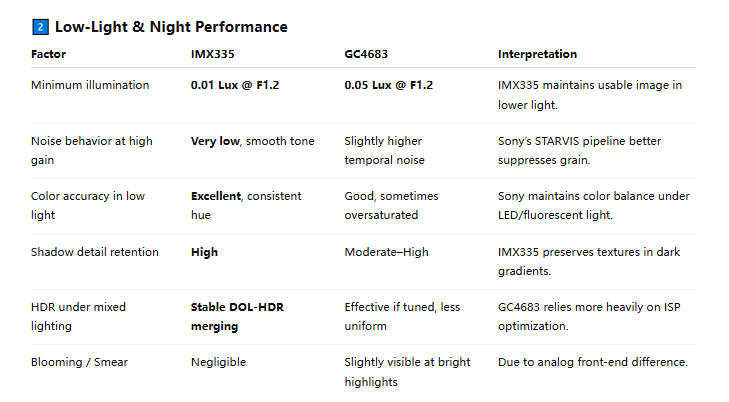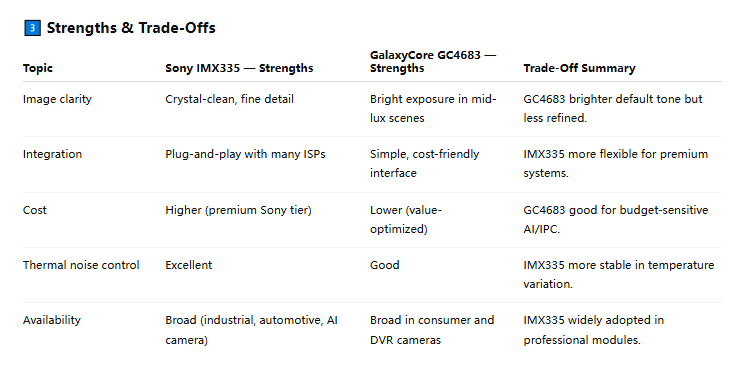
This Goobuy engineer analysis defines the 4MP/5MP (IMX335 vs. GC4683) sensor trade-offs for AI retail & kiosk projects, helping engineers select the right hardware.
Resolution vs. Efficiency: A Technical Analysis of Sony IMX335 vs. GalaxyCore GC4683 for AI Retail
For any engineering team designing an AI-powered retail kiosk, self-checkout system, or smart digital sign for 2026, the hardware debate inevitably lands on a critical decision: do you specify for maximum resolution, or for maximum efficiency?
This isn't just a spec-sheet comparison; it's a decision that impacts your BOM cost, your AI model's performance (FPS), and your edge processor's (e.g., Jetson, Rockchip) computational load.
This dilemma is perfectly encapsulated by two of the market's most prominent 2.0µm-pixel sensors:
Choosing wrong is costly. Over-speccing with 5MP can bottleneck your edge device and inflate your BOM. Under-speccing with 4MP might prevent your AI model from performing critical long-range analytics.
This article is a deep technical analysis designed to resolve this exact IMX335 vs. GC4683 debate. We will move beyond the datasheets to compare real-world performance trade-offs, helping you select the right sensor for your specific AI edge application.
This battleground is where most mainstream AI edge projects live. The pixels are smaller (2.0µm), and the debate shifts from pure low-light to a balance of resolution, WDR, and cost-efficiency.
On-Paper Specification (Tale of the Tape)
| Feature | Sony IMX335 (STARVIS) | GalaxyCore GC4683 |
| Resolution | 5.14MP (2592x1944) | 4MP (2560x1440) |
| Sensor Size | 1/2.8" | 1/3" |
| Pixel Size | 2.0µm | 2.0µm |
| Technology | STARVIS (BSI) | BSI |
| WDR | DOL-WDR (3-exposure) | Staggered WDR |
|
Attribute |
Sony IMX335 |
GalaxyCore GC4683 |
Notes |
|
Resolution |
2592 × 1944 (5 MP) |
2560 × 1440 (4 MP) |
IMX335 provides slightly higher resolution and pixel density. |
|
Optical Format |
1/2.8″ |
1/3″ |
IMX335 has a slightly larger photosensitive area. |
|
Pixel Size |
2.0 µm × 2.0 µm |
2.9 µm × 2.9 µm |
GC4683 gains light sensitivity per pixel but trades off resolution. |
|
Shutter Type |
Rolling (Progressive Scan) |
Rolling |
Both suited for compact camera modules. |
|
Technology |
Sony STARVIS (BSI) |
GalaxyCore Starlight (BSI) |
Both are backside-illuminated low-light designs. |
|
Typical Frame Rate |
30 fps @ 5 MP / 60 fps @ 1080p |
60 fps @ 2 K / 30 fps @ 4 MP |
IMX335 offers flexible resolution scaling. |
|
Dynamic Range |
~72 dB (DOL-HDR capable) |
~70 dB (HDR supported) |
Both sensors support multi-exposure HDR. |
|
SNR (typical) |
40 dB + |
38 dB + |
Sony’s analog front-end usually yields cleaner output. |
|
Ecosystem / Driver support |
Very mature (global ISP presets) |
Moderate (used in cost-efficient DVR/IPC designs) |
Affects tuning ease and integration speed. |

|
Factor |
IMX335 |
GC4683 |
Interpretation |
|
Minimum illumination |
0.01 Lux @ F1.2 |
0.05 Lux @ F1.2 |
IMX335 maintains usable image in lower light. |
|
Noise behavior at high gain |
Very low, smooth tone |
Slightly higher temporal noise |
Sony’s STARVIS pipeline better suppresses grain. |
|
Color accuracy in low light |
Excellent, consistent hue |
Good, sometimes oversaturated |
Sony maintains color balance under LED/fluorescent light. |
|
Shadow detail retention |
High |
Moderate–High |
IMX335 preserves textures in dark gradients. |
|
HDR under mixed lighting |
Stable DOL-HDR merging |
Effective if tuned, less uniform |
GC4683 relies more heavily on ISP optimization. |
|
Blooming / Smear |
Negligible |
Slightly visible at bright highlights |
Due to analog front-end difference. |

|
Topic |
Sony IMX335 — Strengths |
GalaxyCore GC4683 — Strengths |
Trade-Off Summary |
|
Image clarity |
Crystal-clean, fine detail |
Bright exposure in mid-lux scenes |
GC4683 brighter default tone but less refined. |
|
Integration |
Plug-and-play with many ISPs |
Simple, cost-friendly interface |
IMX335 more flexible for premium systems. |
|
Cost |
Higher (premium Sony tier) |
Lower (value-optimized) |
GC4683 good for budget-sensitive AI/IPC. |
|
Thermal noise control |
Excellent |
Good |
IMX335 more stable in temperature variation. |
|
Availability |
Broad (industrial, automotive, AI camera) |
Broad in consumer and DVR cameras |
IMX335 widely adopted in professional modules. |

Here, the specs diverge. Sony offers higher resolution (5MP) on a slightly larger sensor, while GalaxyCore targets a "true" 16:9 4MP (2K) output. This GC4683 2K sensor vs Sony 5MP sensor matchup has significant implications for AI.
Deep Dive: IMX335 vs. GC4683 Performance Analysis
The Sony IMX335 is a legend. Its 5MP resolution is its greatest asset. For an AI model, more pixels mean more data. This is critical for applications requiring digital zoom—for example, identifying a face or license plate from a distance. A IMX335 Jetson Nano camera solution, while computationally heavier, can digitally zoom and still retain a 1080p image. Its STARVIS pedigree provides excellent low-light performance for a 2.0µm pixel, and its DOL-WDR is robust. This sensor often competes with its 4K big brother, the IMX415, leading to the IMX335 vs IMX415 debate (where IMX415 offers 4K but with much smaller 1.45µm pixels, sacrificing low-light sensitivity).
The GalaxyCore GC4683 is the pragmatist's choice. Its 4MP (2560x1440) resolution is computationally efficient. It delivers a perfect 16:9 2K stream, which is often all an AI model or a standard display needs, without the overhead of processing 5MP. The GC4683 sensor 4MP performance is impressive for its cost bracket, leveraging its BSI architecture for clean images. Its primary advantage is value—it delivers a fantastic 4MP image at a BOM cost that allows for aggressive pricing on a 4MP USB camera for AI digital signage.
|
Use Case |
IMX335 |
GC4683 |
Comment |
|
AI Edge / Robotics |
5 |
4 |
IMX335 preferred for HDR + low-noise robotics. |
|
Digital Signage / Kiosk |
5 |
5 |
Both sufficient; GC4683 more cost-effective. |
|
Industrial Machine Vision |
5 |
4 |
IMX335 cleaner output for analytics. |
|
Security / Night Monitoring |
5 |
4 |
IMX335 retains color in sub-lux; GC4683 may grayscale early. |
|
Budget DVR / Consumer IPC |
3 |
5 |
GC4683 wins in cost-performance. |
The Verdict: IMX335 vs GC4683 for AI retail kiosk
This is the perfect application test case.
Sony IMX335 sets the benchmark for 5 MP STARVIS low-light clarity and HDR stability, while GalaxyCore GC4683 provides a practical, lower-cost 4 MP alternative delivering bright images and solid starlight performance for mainstream AI and industrial vision systems.
As a CTO or product manager, you must understand this critical truth: a perfectly chosen sensor, when poorly integrated, will fail your project.
Choosing the IMX335 or the GC4683 is the 20% (the "what"). The other 80% is the engineering that turns that raw sensor into a reliable product:
FAQ
1. Question: For a cost-sensitive AI retail kiosk, is the IMX335's 5MP resolution worth the extra cost over the 4MP GC4683?
Answer: The GalaxyCore GC4683 is often the definitive choice for computationally efficient, 16:9 4MP (2K) applications. The Sony IMX335's value is defined by its higher 5MP resolution, which becomes necessary only if the AI application relies heavily on digital zoom for long-range analytics.
2. Question: Is a 5MP sensor like the IMX335 always better for AI object detection than a 4MP sensor like the GC4683?
Answer: No. "Better" is defined by the project's compute budget. While the IMX335 provides more data (pixels), it requires significantly more CPU/GPU resources for processing. The GC4683's 4MP stream is often a more balanced load, resulting in a higher FPS (frames-per-second) AI pipeline, which is critical for many real-time edge devices.
3. Question: For a Jetson Nano project, how hard is it to find UVC modules for both the IMX335 and the GC4683 to compare them?
Answer: Both sensors are widely adopted by integrators and are available in the UVC (USB Video Class) ecosystem. The integration ease is defined by the module's firmware. A professional supplier will ensure their modules (whether using the IMX335 or GC4683) are fully UVC-compliant, making them plug-and-play on Linux platforms like the Jetson Nano.
4. Question: "If I buy a raw IMX307 MIPI module, will its low-light image look as good as the demos I see online?"
Answer: This is a common misconception. The answer is no. A MIPI module outputs raw, unprocessed data (e.g., RAW10 format). The beautiful demo images you see are the result of heavy ISP (Image Signal Processor) tuning, which handles the de-mosaicing, noise reduction, and color correction. This tuning is a complex, specialized task. In contrast, a "finished" USB camera module has an expert-tuned ISP built-in. You are buying a finished, optimized "image," not just a "raw sensor."
5. Question: "From a Bill of Materials (BOM) perspective, isn't a MIPI module cheaper than a USB module?"
Answer: This question requires analyzing the "Total Cost of Ownership" (TCO), not just the BOM. The MIPI module component unit price is almost always lower than a finished USB module (which includes a USB controller, ISP, crystal, and housing). However, the MIPI path introduces massive hidden costs: NRE (Non-Recurring Engineering) fees for driver development and, most importantly, 6-12 months of your own engineering team's salary. For any project not shipping in the hundreds of thousands, a UVC USB module is defined by its significantly lower TCO and faster path to revenue.
This article itself is a real-world demonstration of our core value: we are not just a supplier, we are the integration partner who understands the critical, real-world trade-offs between sensors like the Sony IMX335 and the GalaxyCore GC4683.
We understand that the sensor is just the start. The real project-defining value is in the expert ISP tuning, lens matching, and stable firmware that turns a raw sensor into a reliable, plug-and-play UVC module for your AI platform.
Stop agonizing over datasheets. You've done the research.
Contact the Goobuy engineering team today to discuss your specific AI retail or kiosk project, or [Order one of our 4MP/5MP Evaluation Kits] to test a fully-tuned module in your lab this week."
useful relative technical articles and products
1, Sony STARVIS IMX335 USB3.0 Camera Module low light 0.01Lux (imx335 USB cam products)
2, STARVIS IMX335 USB Camera: 5MP Starlight Vision for Industry
3, STARVIS vs STARVIS 2: IMX385 & IMX335 Industrial Review
4, STARVIS IMX291 vs IMX335 vs IMX415: Night Vision Camera Guide
5, STARVIS IMX291 vs IMX335 vs IMX415: Night Vision Camera Guide (2)
6, IMX335 USB3.0 Camera: Great Lakes Vision & Security Solution STARVIS